check oil GMC SAVANA 1996 Owners Manual
[x] Cancel search | Manufacturer: GMC, Model Year: 1996, Model line: SAVANA, Model: GMC SAVANA 1996Pages: 372, PDF Size: 18.81 MB
Page 110 of 372
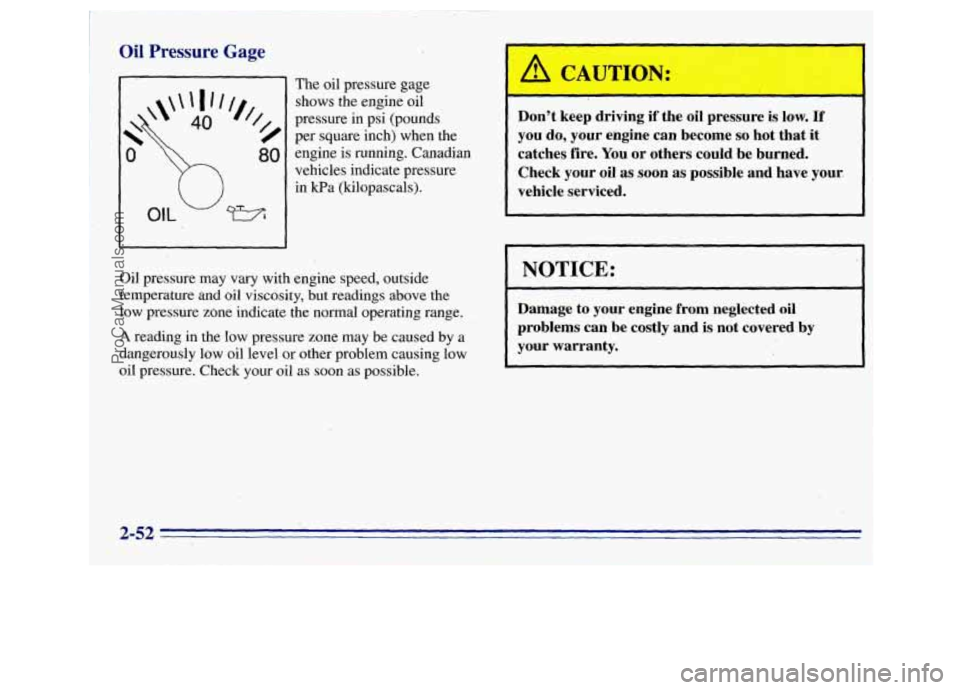
Oil Pressure Gage
The oil pressure gage shows the engine oil
pressure in psi (pounds
per square inch) when the engine is running. Canadian
vehicles indicate pressure
Oil pressure may vary with engine speed, outside
temperature and oil viscosity,
but readings above
the
lowpressure zone indicate the normal operating range.
A reading in the low pressure zone may be caused by a
dangerously low oil level or other problem causing low
oil pressure. Check'your oil as
soon as possible.
Don't keep driving if the oil pressure is low. If
you do, your engine can become so hot that it
catches fire. You or others could be burned.
Check your oil
as soon as possible and have your.
vehicle serviced.
I
I
NOTICE: '1 ~
Damage to your engine from neglected oil
problems can be costly and
is not covered by
your warranty.
ProCarManuals.com
Page 111 of 372

Check Gages Light
The CHECK GAGES light
will come on briefly when
you are starting
the engine.
CHECK
GAGES
Fuel Gage
*
\\'
E
FUEL ONLY
UNLEADED
The fuel gage, when the
ignition is on, tells you
about how much
fuel you
have left
in your tank.
If the light comes on and stays on while you are dri\iing,
check your coolant temperature and engine oil pressure
gages to see
if they are in the warning zones. The
gage will first indicate
EMPTY (E) before you
are out
of fuel, and you should get more fuel as soon
as
possible.
2-53
ProCarManuals.com
Page 168 of 372
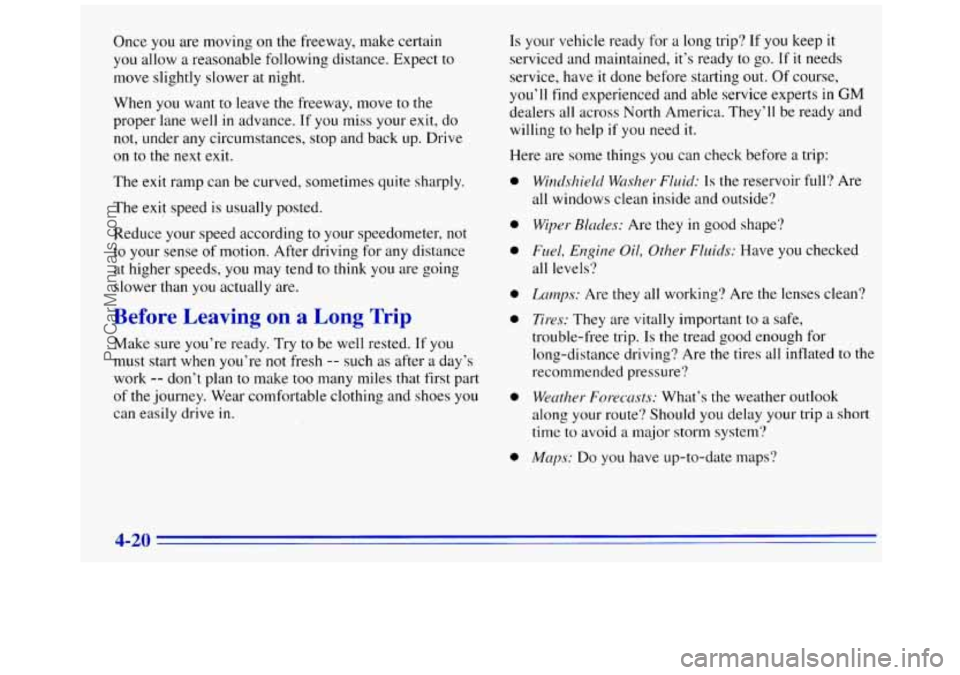
Once you are moving on the freeway, make certain
you allow a reasonable following distance. Expect to
move slightly slower at night.
When you want to leave
the freeway, move to the
proper lane well
in advance. If YOLI miss your exit, do
not, under any circumstances, stop and back up. Drive
on
to the next exit.
The exit ramp can be curved, sometimes quite sharply.
The exit speed is usually posted. Reduce your speed according
to your speedometer, not
to your sense of motion. After driving for any distance
at higher speeds,
you may tend to think you are going
slower than you actually are.
Before Leaving on a Long Trip
Make sure you’re ready. Try to be well rested. If you
must start when you’re not fresh
-- such as after a day’s
work
-- don’t plan to make too many miles that first part
of
the journey. Wear comfortable clothing and shoes you
can easily drive
in.
Is your vehicle ready for a long trip? If you keep it
serviced and maintained, it’s ready to go. If it needs
service, have it done before starting
out. Of course,
you’ll find experienced and able service experts
in GM
dealers
all across North America. They’ll be ready and
willing to help
if you need it.
Here are some things you can check before a trip:
0
0
0
0
0
0
0
Windshield Wclsher Fluid: Is the reservoir full? Are
all windows clean inside and outside?
Wiper- Blcrdes: Are they in good shape?
Fuel, Engine Oil, Other FlLtids: Have you checked
all levels?
Lnlnps: Are they all working? Are the lenses clean?
Tires: They are vitally important to a safe,
trouble-free trip.
Is the tread good enough for
long-distance driving? Are
the tires all inflated to the
recommended pressure?
Weather Forecasts: What’s the weather outlook
along your route‘? Should you delay your trip a short
time
to avoid a major storm system?
Maps: Do you have up-to-date maps‘?
4-20
ProCarManuals.com
Page 185 of 372
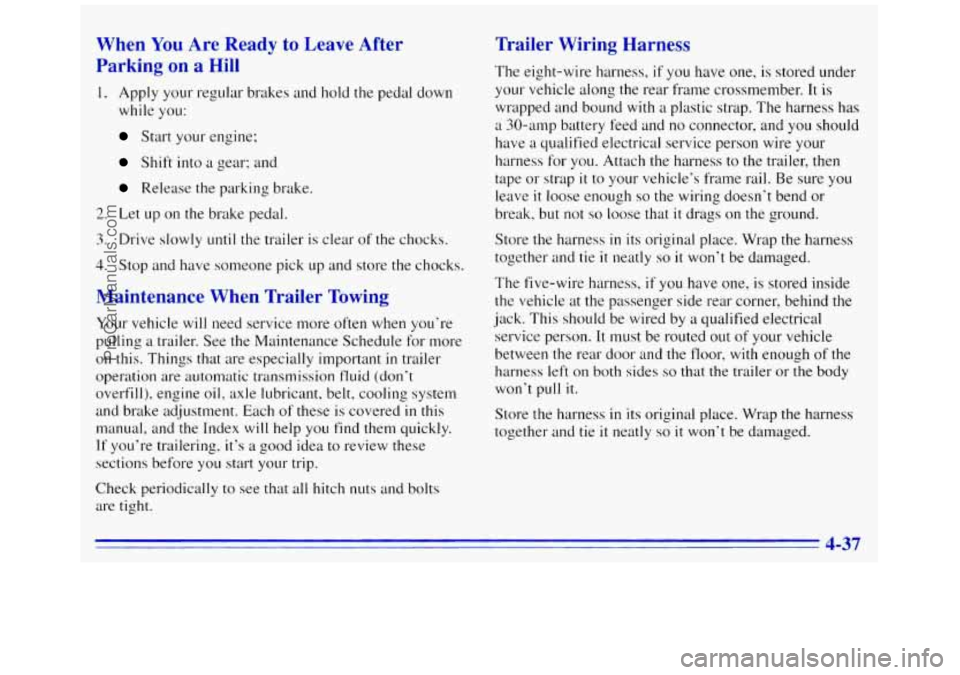
When You Are Ready to Leave After
Parking
on a Hill
1. Apply your regular brakes and hold the pedal down
while you:
Start your engine:
Shift into a gear: and
Release the parking brake.
2. Let up on the brake pedal.
3. Drive slowly until the trailer is clear of the chocks.
4. Stop and have someone pick up and store the chocks.
Maintenance When Trailer Towing
Your vehicle will need service more often when you’re
pulling a trailer. See the Maintenance Schedule for more
on this. Things that are especially important
in trailer
operation are automatic transmission
fluid (don’t
overfill), engine oil, axle lubricant, belt, cooling system
and brake adjustment. Each
of these is covered in this
manual, and the Index will help
you find them quickly.
If you‘re trailering, it‘s a good idea to review these
sections before you start your trip.
Check periodically to see that
all hitch nuts and bolts
are tight.
Trailer Wiring Harness
The eight-wire harness, if you have one, is stored under
your vehicle along the rear frame crossmember.
It is
wrapped and bound with a plastic strap. The harness has
a 30-anlp battery feed and no connector, and you should
have a qualified electrical service person wire your
harness for you. Attach the harness
to the trailer, then
tape or strap
it to your vehicle’s frame rail. Be sure you
leave
it loose enough so the wiring doesn’t bend or
break, but not
so loose that it drags on the ground.
Store the harness
in its original place. Wrap the harness
together and tie
it neatly so it won’t be damaged.
The five-wire harness,
if you have one, is stored inside
the vehicle at the passenger side rear corner, behind the
jack. This should be wired by a qualified electrical
service person. It must be routed out
of your vehicle
between the rear door and the floor,
with enough of the
harness left on both sides
so that the trailer or the body
won’t pull
it.
Store the harness in its original place. Wrap the harness
together and tie
it neatly so it won’t be damaged.
4-37
ProCarManuals.com
Page 228 of 372

Fuels in Foreign Countries
-- Gasoline Engines
If you plan on driving in another country outside the
United States or Canada, the proper fuel may be hard to
find. Never use leaded gasoline or any other fuel not
recommended in the previous text on fuel. Costly repairs
caused by use
of improper fuel wouldn’t be covered by
your warranty.
To check on fuel availability, ask an auto club, or
contact a major
oil company that does business in the
country where you’ll be driving.
You can also write
us at the following address for
advice.
Just tell us where you’re going and give your
Vehicle Identification Number (VIN).
General Motors Overseas Distribution Corporation,
North American Export Sales (NAES)
1908 Colonel Sam Drive
Oshawa, Ontario
L 1 H 8P7
Filling Your Tank
Gasoline vapor is highly flammable. It burns
violently, and that can cause very bad injuries.
Don’t smoke if you’re near gasoline or refueling
your vehicle. Keep sparks, flames and smoking
materials away from gasoline.
6-4
ProCarManuals.com
Page 235 of 372

Engine Oil (Gasoline Engine)
If your vehicle has a diesel engine, see “Engine Oil
(Diesel Engine)” in the Diesel Engine Supplement.
It‘s
a good idea to check your engine oil every time you
be warm and the vehicle must be on level ground.
c‘ Get fuel. In order to get an accurate reading, the oil must
Turn
off the engine and give
the oil
a few minutes to drain
back into the
oil pan. If you
don’t, the oil dipstick might
not show the actual level.
Checking Engine Oil
Pull out the dipstick and clean it with a paper towel or
cloth, then push
it back in all the way. Remove it again,
keeping the tip down, and check the level.
When to Add Oil
If the oil is at or below the ADD mark, then ~011’11 need to
add some oil. But you must use the right kind. This part
explains what kind
of oil to use. For crankcase capacity,
see “Capacities and Specifications”
in the Index.
NOTICE:
Don’t add too much oil. If your engine has so much
oil that the oil level gets above the upper mark that
shows the proper operating range, your engine could be damaged.
ProCarManuals.com
Page 240 of 372
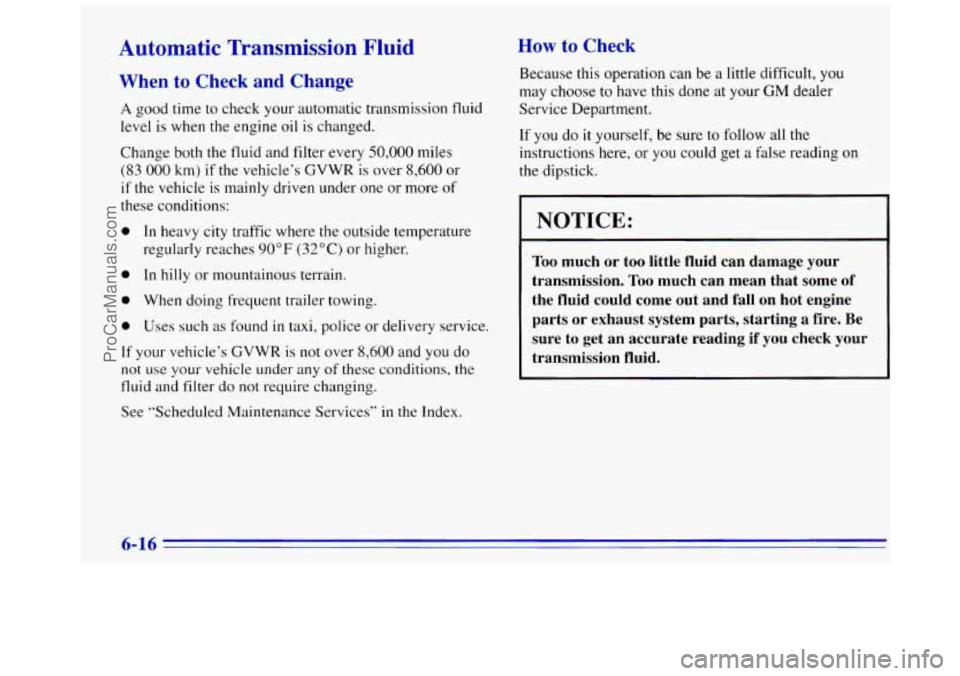
Automatic Transmission Fluid
7 ’ ~ n to Check and Change
A good time to check your automatic transmission fluid
level is when the engine oil is changed.
Change
both the fluid and filter every 50,000 miles
(83 000 km) if the vehicle’s GVWR is over 8,600 or
if
the vehicle is mainly driven under one or more of
these conditions:
0 In heavy city traffic where the outside temperature
0 In hilly or mountainous terrain.
0 When doing frequent trailer towing.
regularly
reaches
90°F (32°C) or higher.
0 Uses such as found in taxi, police or delivery service.
If your vehicle’s GVWR is not over 8,600 and you do
not use your vehicle under any of these conditions, the
fluid and filter do not require changing.
See “Scheduled Maintenance Services”
in the Index.
How to Check
Because this operation can be a little difficult, you
may choose to have this done at your GM dealer
Service Department.
If you do it yourself, be sure to follow all the
instructions here, or you could get
a false reading on
the dipstick.
NOTICE:
Too much or too little fluid can damage your
transmission.
Too much can mean that some of
the fluid could come out and fall on hot engine parts or exhaust system parts, starting a fire. Be
sure to get an accurate reading if you check your
transmission fluid.
ProCarManuals.com
Page 290 of 372

Cooling System Capacity
ENGINE VIN
“VORTEC” 4300 W
“VORTEC” SO00 M
“VORTEC” 5700 R
“VORTEC” 7400 J
QTY Without Rear Heater*
1 1 quarts ( 10.4 L)
17 quarts ( 16 L)
17 quarts (16 L)
23 quarts (2 1.8 L)
QTY With Rear Heater*
14 quarts (13.2 L)
20 quarts (18.9 L)
20 quarts (1 8.9 L)
26 quarts (24.6 L)
After refill, the level MUST be checked as outlined under “Engine Cooling System” in Section 5.
*All quantities are approximate.
Crankcase Capacity
ENGINE VIN
“VORTEC” 4300 W
“VORTEC” 5000 M
“VORTEC” 5700 R
“VORTEC” 7400 J
Quantity With Filter
4.5 quarts (4.3 L)
5 quarts (4.8 L)
5 quarts (4.8 L)
7 quarts (6.5 L)
All quantities are approximate.
After refill, the level
MUST be checked as outlined under “Engine Oil And Filter Recommendations” in Section 5.
*Add an aS;lditis.ad quart (1 L) for RPO 5ZI and RPO KL5 Models.
6-66
ProCarManuals.com
Page 300 of 372
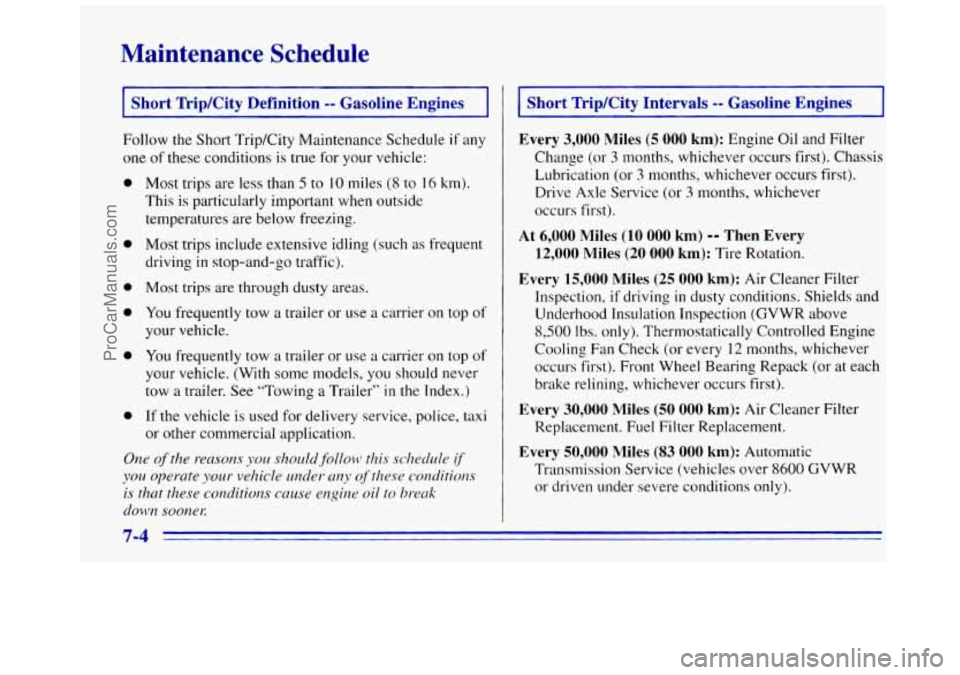
Maintenance Schedule
Short TripKity Definition -- Gasoline Engines i
Follow the Short Trip/City Maintenance Schedule if any
one of these conditions is true for your vehicle:
0
0
0
0
0
e
Most trips are less than 5 to 10 miles (8 to 16 km).
This is particularly important when outside
temperatures are below freezing.
Most trips include extensive idling (such as frequent
driving
in stop-and-go traffic j.
Most trips are through dusty areas.
You frequently tow
a trailer or use a carrier on top of
your vehicle.
You frequently tow
a trailer or us-e a carrier on top of
your vehicle. (With some models, you should never
tow
a trailer. See “Towing a Trailer” in the Index.)
If the vehicle is used for delivery service, police, taxi
or other commercial application.
Short Trip/City Intervals -- Gasoline Engines
Every 3,000 Miles (5 000 km): Engine Oil and Filter
Change (or
3 months, whichever occurs first). Chassis
Lubrication (or
3 months, whichever occurs first).
Drive Axle Service (or
3 months, whichever
occurs first).
At 6,000 Miles (10 000 km) -- Then Every
12,000 Miles (20
000 km): Tire Rotation.
Every 15,000 Miles (25 000 km): Air Cleaner Filter
Inspection,
if driving in dusty conditions. Shields and
Underhood Insulation Inspection (GVWR above
8,500 Ibs. only). Thermostatically Controlled Engine
Cooling Fan Check (or every
12 months, whichever
occurs first). Front Wheel Bearing Repack (or at each
brake relining, whichever occurs first).
Every 30,000 Miles (50 000 km): Air Cleaner Filter
Replacement. Fuel Filter Replacement.
Every 50,000 Miles (83 000 km): Automatic
Transmission Service (vehicles over
8600 GVWR
or driven under severe conditions only).
7-4
ProCarManuals.com
Page 302 of 372
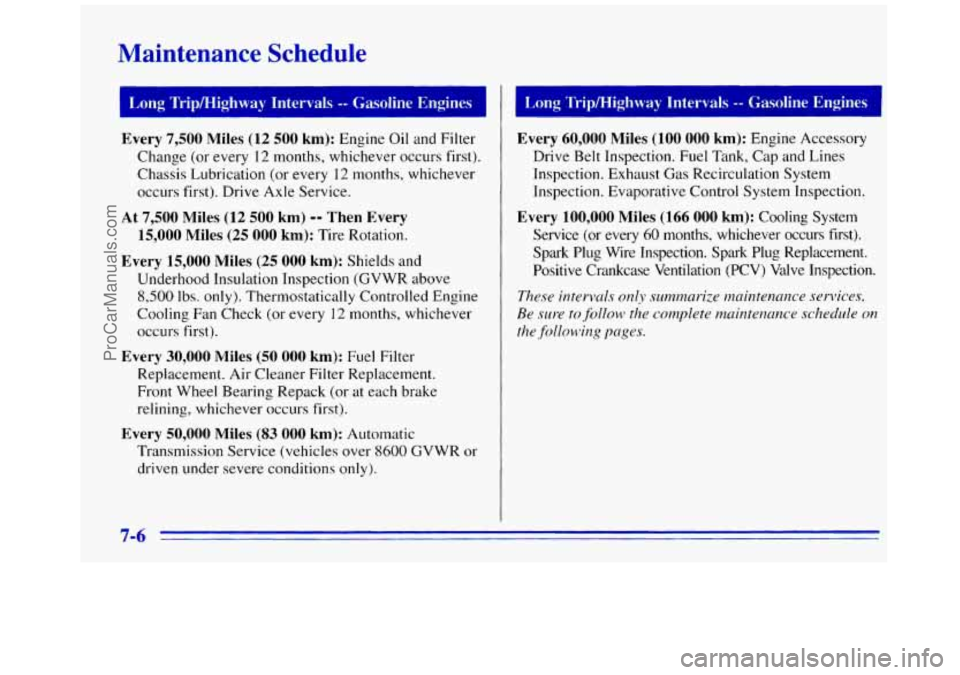
Maintenance Schedule
Every 7,500 Miles (12 500 km): Engine Oil and Filter
Change (or every 12 months, whichever occurs first).
Chassis Lubrication (or every 12 months, whichever
occurs first). Drive Axle Service.
At 7,500 Miles (12 500 km) -- Then Every
15,000 Miles
(25 000 km): Tire Rotation.
Every 15,000 Miles (25 000 km): Shields and
Underhood Insulation Inspection (GVWR above
8,500 lbs. only). Thermostatically Controlled Engine
Cooling Fan Check
(or every 12 months, whichever
occurs first).
Every 30,000 Miles (50 000 km): Fuel Filter
Replacement. Air Cleaner Filter Replacement.
Front Wheel Bearing Repack (or at each brake
relining, whichever occurs first).
Every 50,000 Miles (83 000 km): Automatic
Transmission Service (vehicles over
8600 GVWR or
driven under severe conditions only).
Every 60,000 Miles (100 000 km): Engine Accessory
Drive Belt Inspection. Fuel
Tank, Cap and Lines
Inspection. Exhaust Gas Recirculation System
Inspection. Evaporative Control System Inspection.
Every 100,000 Miles (166 000 km): Cooling System
Service (or every
60 months, whichever occurs fist).
Spark Plug Wire Inspection. Spark
Plug Replacement.
Positive Crankcase Ventilation (PCV) Valve Inspection.
These intervals only sumnarize maintenance services.
Be sure to follow the complete maintenance schedule on
the.following pnges.
7-6
ProCarManuals.com